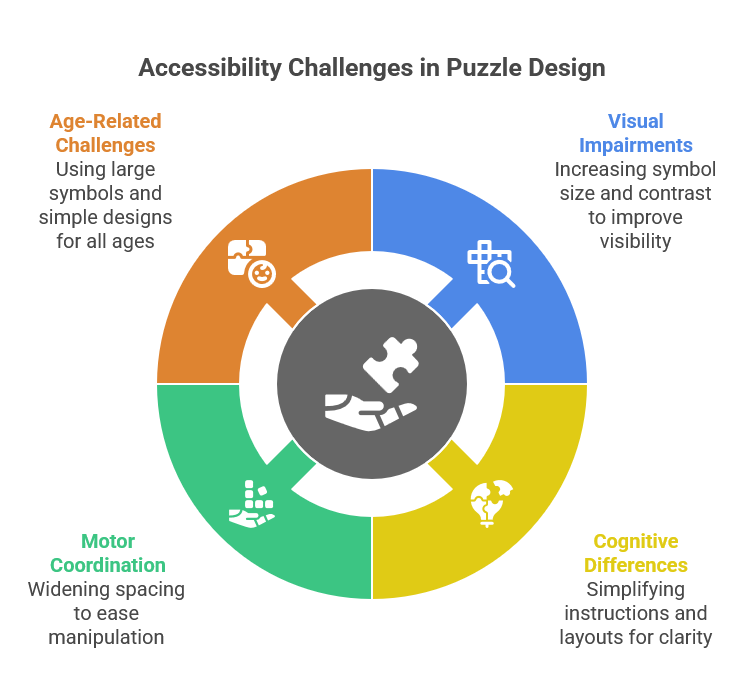Creating Accessible and Inclusive Puzzles: Seek and Find for Every Learner
How to design Seek and Find puzzles that are engaging, inclusive, and adaptable for learners of all abilities.
Introduction: Puzzles for Everyone
Puzzles should be fun — and they should be for everyone. Whether you’re designing for classrooms, therapy settings, or family puzzle books, accessibility and inclusion are key. Visual puzzles like Seek and Find are naturally flexible, making them ideal for a wide range of learners, from preschoolers to seniors, and for people with diverse needs.
With Puzzle Maker Pro – Seek and Find, you can customize every visual and layout detail, ensuring puzzles are not only enjoyable but also clear, readable, and inclusive.
Why Accessibility Matters in Puzzle Design
Accessibility is about creating puzzles that everyone can enjoy — regardless of age, visual ability, or learning style. For educators, accessible puzzles mean all students can participate equally. For publishers, it means reaching wider audiences and building goodwill with customers.
Inclusive puzzle design ensures that:
- Everyone can engage with the activity independently or collaboratively.
- Puzzles don’t rely on assumptions about visual, cognitive, or motor abilities.
- Design choices (color, density, symbols) support comprehension and clarity.
When puzzles are accessible, they become tools for inclusion — helping people connect, learn, and succeed together.
Understanding Accessibility Challenges

To design puzzles that work for all learners, it helps to consider common challenges:
1. Visual Impairments
Low contrast, small symbols, or dense layouts can make puzzles hard to see. The fix? Increase symbol size, spacing, and contrast.
2. Cognitive Differences
Complex instructions or overly busy designs can overwhelm some users. Using simpler legends and clear layouts makes puzzles more approachable.
3. Motor Coordination
Small icons or tightly packed grids can frustrate players who struggle with fine motor control. Wider spacing helps maintain accessibility.
4. Age-Related Challenges
Seniors and young children often benefit from similar adjustments: large symbols, simple designs, and easy-to-read legends.
By thinking about these factors early in the design process, you make puzzles that are more enjoyable and meaningful for everyone.
Inclusive Design Principles for Seek and Find Puzzles
Seek and Find puzzles are naturally adaptable. You can tailor them to suit different learning environments and user needs with just a few design decisions.
1. Prioritize Clarity and Contrast
- Use strong visual contrast between symbols and background.
- Avoid clutter and overlapping elements.
- Choose distinct shapes and colors — avoid subtle variations that may look similar.
2. Adjust Grid Size and Density
- Young learners or low-vision players: smaller grids (6×6 to 8×8) with low fill density.
- Advanced learners: larger grids (12×12 or more) with moderate to high density.
3. Use Recognizable Symbols
Familiar icons (animals, fruits, letters) are more inclusive than abstract shapes. They also help multilingual learners or those with language barriers engage visually without reading.
4. Offer Multiple Ways to Play
Encourage players to:
- Circle or highlight items found.
- Use a legend to count items.
- Color in found objects for a creative twist.
These multiple modes support different learning and motor abilities.

Designing for Cognitive and Developmental Diversity
Seek and Find puzzles support a variety of cognitive goals:
- Focus and attention: finding specific items among distractions.
- Memory: recalling what has been found.
- Pattern recognition: identifying relationships between shapes or positions.
To support diverse learners:
- Simplify instructions and legends.
- Include visual examples on each page.
- Maintain predictable layouts across puzzles to reduce cognitive load.
For neurodiverse learners — such as those with autism, ADHD, or dyslexia — structured repetition and clear organization can make puzzles soothing and empowering rather than overwhelming.
Designing for Seniors and Rehabilitation Settings
Seek and Find puzzles are excellent tools for maintaining cognitive agility and fine motor coordination in older adults. They provide:
- Mental stimulation through pattern recognition.
- Relaxation and focus through gentle challenge.
- A sense of accomplishment through completion.
To make puzzles senior-friendly:
- Increase font and symbol size.
- Keep contrast strong (dark symbols on light backgrounds).
- Reduce grid density for readability.
- Avoid excessive rotation or mirroring.
In rehabilitation contexts, therapists can use Seek and Find puzzles for eye-hand coordination and memory exercises. Adjusting puzzle difficulty lets you tailor sessions to individual needs.
Printable Accessibility Checklist for Creators
Use this checklist when designing inclusive Seek and Find puzzles:
- High visual contrast
- Clear, simple instructions
- Large symbols and spacing
- Familiar or theme-relevant images
- Predictable layout structure
- Options for coloring, circling, or counting
- Included solutions
These features ensure your puzzles are not only inclusive but also enjoyable and frustration-free.
The Role of Technology in Inclusive Design
Digital creation tools like Puzzle Maker Pro make inclusive design easier. You can:
- Adjust size and contrast with sliders and presets.
- Preview puzzles before export to ensure readability.
- Create variations instantly with randomized generation.
This flexibility empowers both educators and publishers to produce accessible materials without extra manual editing.
“Accessibility isn’t an afterthought — it’s good design.”
— Educational Designer and Accessibility Advocate
Wrapping Up: Inclusion Through Design
Designing accessible Seek and Find puzzles is about more than compliance — it’s about creativity and empathy. When puzzles are clear, inclusive, and flexible, they invite more people to join the fun of discovery and learning.
Whether you’re designing for classrooms, senior centers, therapy programs, or puzzle enthusiasts, accessibility ensures your creations reach the widest possible audience.
Ready to design puzzles for every learner?
Explore Puzzle Maker Pro – Seek and Find and start creating accessible, engaging puzzles today.
